Overview
Approving timesheets on a desktop provides a comprehensive and efficient way for managers to review, analyze, and approve employee work hours. It enhances accuracy, accessibility, and data security while allowing for more detailed feedback and integration with other business systems.
Security
Role Maintenance

E-Time Role Maintenance; standard Treeview path: E-Time > Security > Role Maintenance
Access to the Timesheet Approval screen can be granted to a user's role in the Security Roles screen located in the E-Time module. This ensures that only authorized personnel can manage timesheet approvals.
NOTE: The Security Roles screen launched from the E-Time module contains security options and settings that are not widely available in the security screens launched from other modules (e.g., CMiC Field, ESS, etc.). The screen being discussed here is only available for assignment in the Security Roles screen located in E-Time.
Approvers
The Timesheet Approval
For more information, please refer to E-Time - Access Codes Administration.
In instances where a user holds program access but lacks approver privileges, accessing the Timesheet Approval screen will launch a discreet screen with a message stating "User is not an Approver."
Filter for Approval
The Filter for Approval feature on the Assign Access Code screen allows for the automatic filtering of employees for respective approvers. For more information, please refer to E-Time - Using Filter for Approval.
Timesheet Approval Log
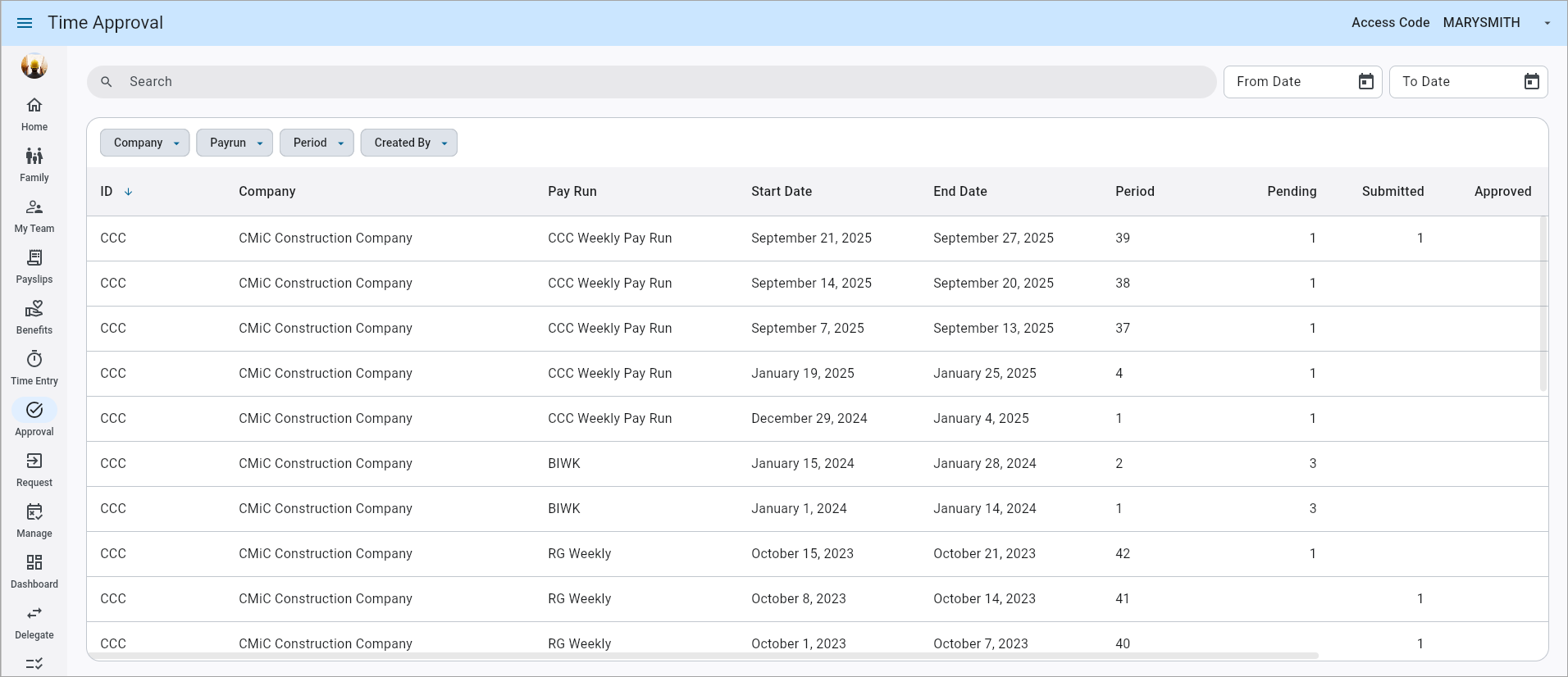
Construct ESS – Timesheet Approval
The Timesheet Approval log groups information according to company, pay run, and period. For users with designated payroll access, the screen displays all records. These users can apply filters to review data, or use the search feature to retrieve specific information. Users can also retrieve data by specifying date ranges.
By default, the screen displays records from the current open period, as well as any forthcoming periods containing timesheet data. It presents open periods within the company's pay cycle where the 'Posted Flag' checkbox remains unchecked and timesheet data exists. Once periods are definitively posted, data from these concluded periods becomes concealed from the log screen's view.
Access Code
Use this drop-down to switch between access codes. Available options include the user's personal access code, authorized group access codes, and a manual login option which allows for manual authentication. Group access codes are created and maintained in the E- Time Access Codes screen. For more information, please refer to E-Time - Access Codes.
Periods
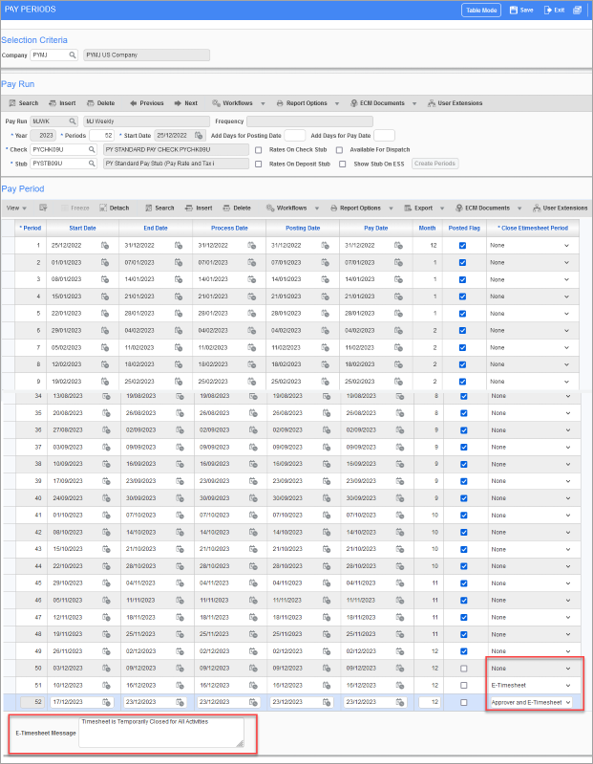
Pgm: PYPAYPRD – Pay Periods; standard Treeview path: US Payroll > Setup > Company > Pay Periods
The US Payroll - Pay Periods screen in the US Payroll module is used to define the periods which make up the pay runs in a company for a specific year.
Data will only be displayed for open periods where the 'Posted Flag' box is unchecked and timesheets exist with any status. Data for periods marked as final and posted will not be shown. This ensures that only relevant and actionable data is presented.
In the case of temporarily closed periods, the following applies:
-
None: The period is available for all operations.
-
E-Timesheet: If the value is set to “E-Timesheet”, the Timesheet Approval screen will not allow the approver to edit any record even though the user has the privilege to edit the submitted timesheets.
-
Approver and E-Timesheet: Data will be displayed, but approval functions will be disabled. Users won't be able to approve timesheets from the desktop or mobile version. All approver functions will be disabled, and a message will be issued in the E-Time Message box to indicate that the timesheet is currently closed for all activities.
Employee Timesheets
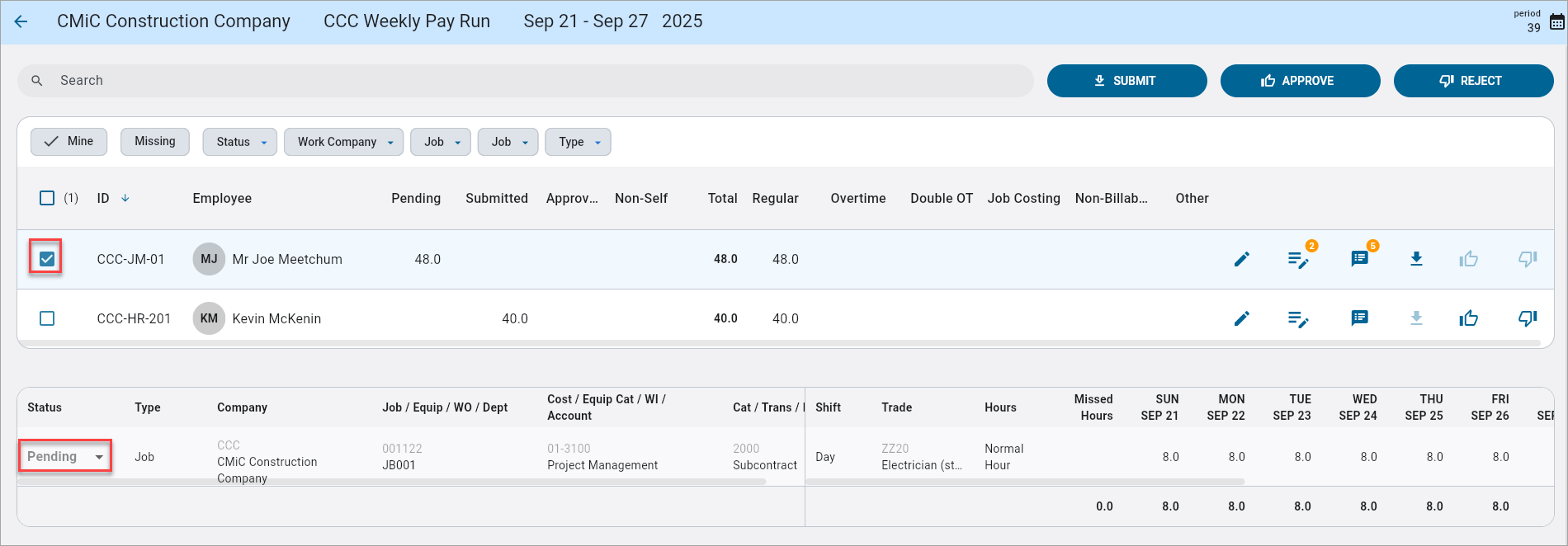
Company pay run and employee selected in Timesheet Approval screen
Individual employee records can be accessed to review specific timesheet details. When an individual employee is selected, a detailed block will appear below the log to display all relevant information about the employee. Filter chips are available to filter data based on job, department, company, and type to narrow down the selection. Refer to Filter Chips for more information. Upon applying these filter chips, the user can then approve the employee based on the selected filter criteria. Refer to Approving/Rejecting Timesheets for more information. This allows for more targeted approval processes tailored to specific parameters. Additionally, the user can submit, approve, or reject individual lines as needed.
NOTE: Users must have the 'Show WBS Code on E-Timesheet (JSP) Entry' and 'Show TAC Code on E-Timesheet (JSP) Entry' boxes checked on the E-Timesheet tab of the System Options screen in the System Data module to view the WBS and TAC fields in the detailed block. The WBS and TAC codes are only available for Construct ESS web. For more information, please refer to System Data - System Options - E-Timesheet - Tab.
Approving/Rejecting Timesheets
From the Timesheet Approval log screen, users can navigate to specific companies, pay runs, and periods.

Company pay run selected in Timesheet Approval screen
Selecting a pay run will display a comprehensive list of employee timesheets for the designated pay run. Regardless of who created the records, the system displays records matching the selected criteria. Users can drill down into the details based on selected criteria.
The Header section displays company, pay run, period number, period start date, period end date, and year. These fields are read-only.
If an employee's timesheet has been submitted, it can be selected for approval or rejection. If an employee's timesheet is in a pending status, the icons to approve or reject will be disabled. Attempting to approve or reject will have no effect, and records will remain in the pending status until they are submitted by the user.
Calendar
The Calendar icon (![]() ) is available to select specific period dates. If the period is posted, no data will be rendered.
) is available to select specific period dates. If the period is posted, no data will be rendered.
Search
The Search box can be used to look up employees by name or employee ID.
Notes
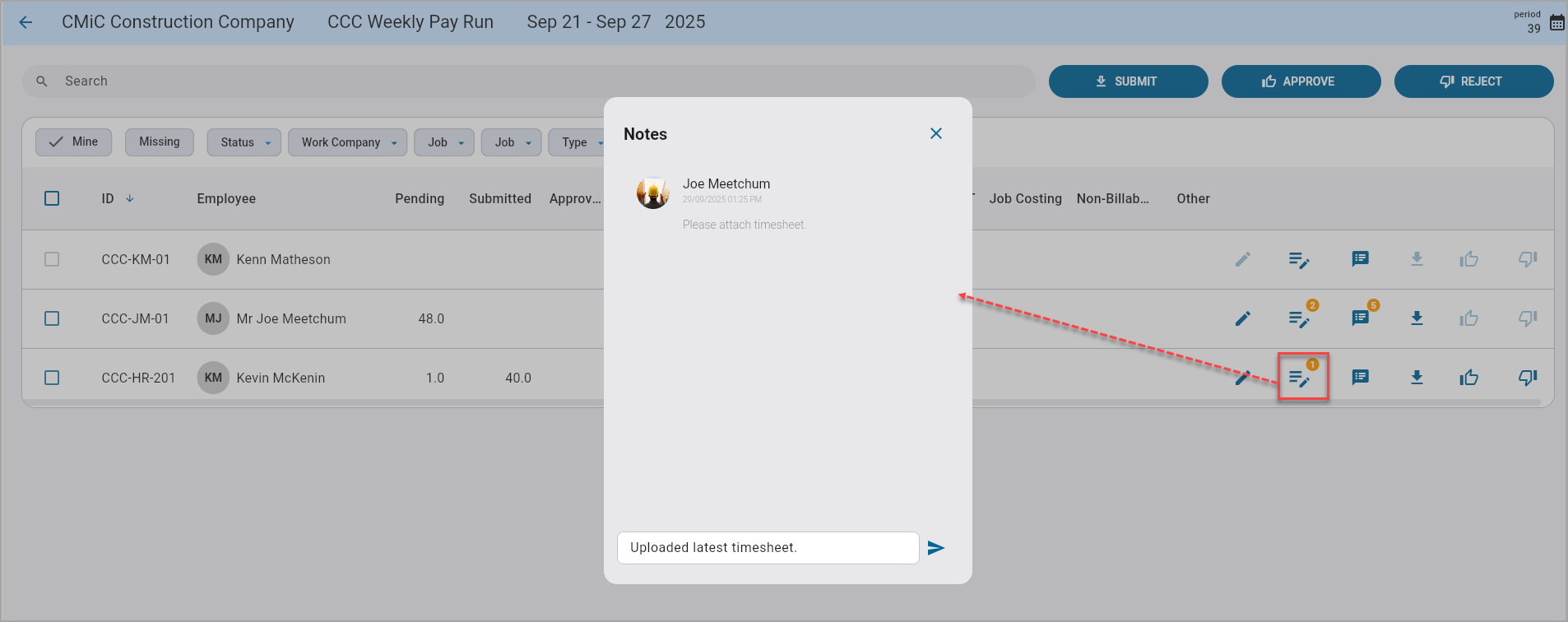
The Notes icon (![]() ) is used to enter notes for a specific employee and to view and reply to submitted notes. This feature is available on each row, and the number badge indicates the number of notes entered for the individual employee.
) is used to enter notes for a specific employee and to view and reply to submitted notes. This feature is available on each row, and the number badge indicates the number of notes entered for the individual employee.
Employees can add/edit their own notes and view and reply to manager-entered notes in the Construct ESS - Timesheet Entry screen.
Single Timesheet

Approving/rejecting a single record in the Timesheet Approval screen
A single timesheet record can be selected on an individual row and approved/rejected using the Approve icon (![]() ) or Reject icon (
) or Reject icon (![]() ) or the [Approve] or [Reject] buttons.
) or the [Approve] or [Reject] buttons.
Multiple Timesheets

Approving/rejecting a batch of records in the Timesheet Approval screen
Multiple timesheet records can be selected by checking a number of individual records or by using the Select All checkbox located in the selection column's header to select all of the records at once. If the Select All option is used, this batch selection applies to pending, submitted and approved records and the screen displays the total number of records selected.
When the [Approve] or [Reject] button is pressed, the submitted records are processed for approval or rejection. Approved records will be rejected and pending records will remain in their pending status.
Sorting Timesheets

Sorting can be performed based on any value within the header option, either in ascending or descending order.
Filter Chips
Filter chips are also available to filter data based on various search criteria.
Created By
The Created By chip is used to filter data in the log by user who created the record. The availability of this chip is controlled by the 'Show E-Time Approval by Group' checkbox on the E-Time - Role Maintenance (E-Time Roles) screen. Depending on a user's privileges, the log will be displayed as shown in the following screenshots.
No Privilege to View Created By Data

Example of Timesheet Approval Log when user doesn't have the privilege to view Created By data
If the 'Show E-Time Approval by Group' checkbox is unchecked on a user's role, they will not have the privilege to access data based on the Created By filter and the Timesheet Approval log will be displayed as shown above. It will group data by various parameters: open period, company name, pay run, period start date, period end date, and period number. This information will be presented in a consolidated row. The screen will further classify records into categories such as pending, submitted, approved, and rejected. These categorized records will be shown under respective columns on the screen.
Privilege to View Created By Data
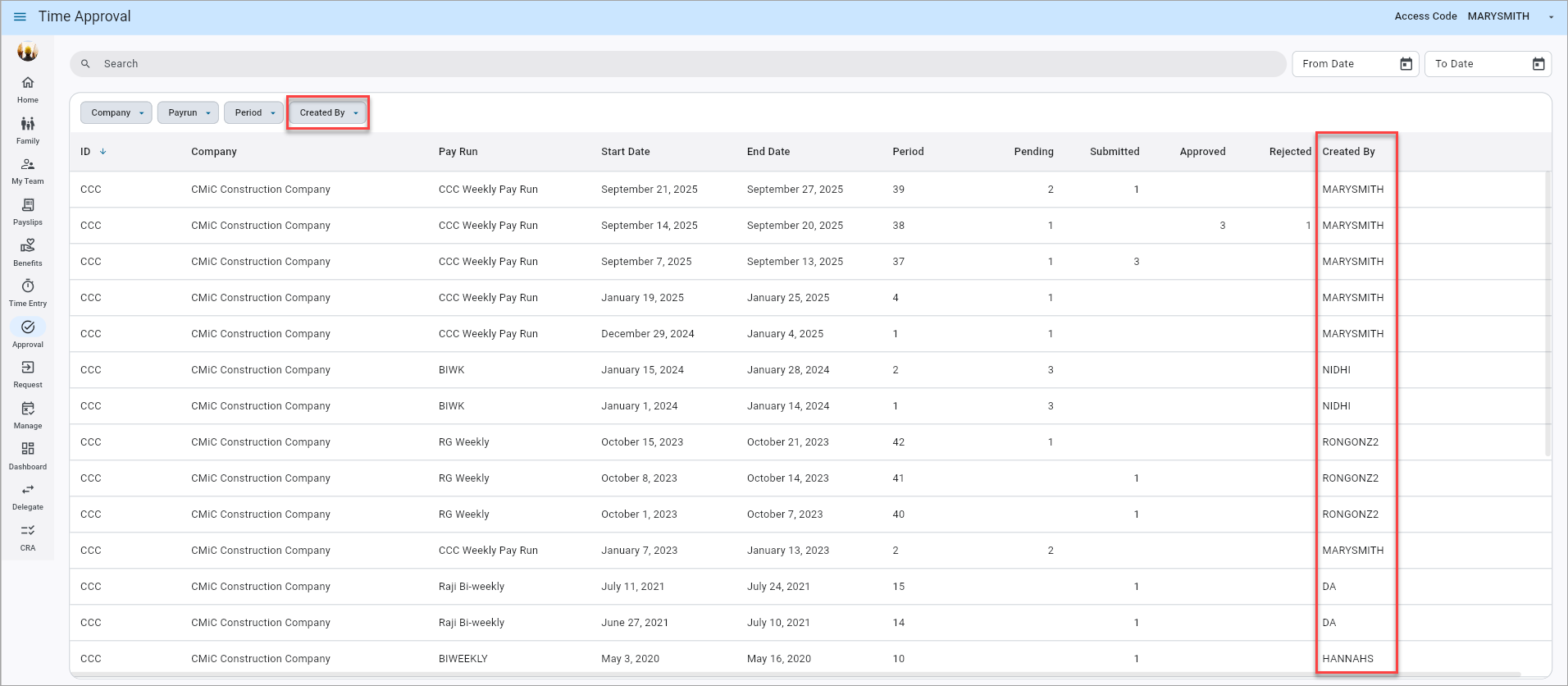
Example of Timesheet Approval Log when user has the privilege to view Created By data
If the 'Show E-Time Approval by Group' checkbox is checked on a user's role, they will have the privilege view data using the Created By filter and the Timesheet Approval log will be displayed as shown above. Records will be organized according to each unique Created By user. However, when a user drills down into these records, all employees' data will be displayed, irrespective of the user who created them.

The screenshot above shows an example of records in a log filtered according to the specific user who created them.
Mine
The Mine filter chip is set to "Yes" by default. When set to "Yes," the system will show all records where the user holds a priority 1 approval level. When set to "No," it displays records where the user is priority 2 or 3.
Company
The Company filter chip is used to filter records by a single company or by multiple companies. The Timesheet Approval screen will dynamically display employees based on the company selections made. This filter allows users to select from all accessible companies and a search bar is available within the filter pop-up to browse for a specific company.
Job
The Job filter chip is used to filter records by a single job or multiple jobs. The Timesheet Approval screen will dynamically display employees based on the job selections made. A search bar is available within the filter pop-up to browse for a specific job.
Department
The Department filter chip is used to select a single department or multiple departments. The Timesheet Approval screen will dynamically display employees based on the department selections made. This filter allows users to select from a list of all departments, and a search bar is available within the filter pop-up to browse for a specific department.
Type
The Type filter chip corresponds to the overhead, job, equipment, and work order lines. Users have the flexibility to select either a single or multiple options. Depending on the selections made, the Timesheet Approval screen will dynamically display the relevant employees. This functionality provides a comprehensive filter spanning all departments, facilitating multi-selection. Additionally, a search bar is integrated to further improve usability.